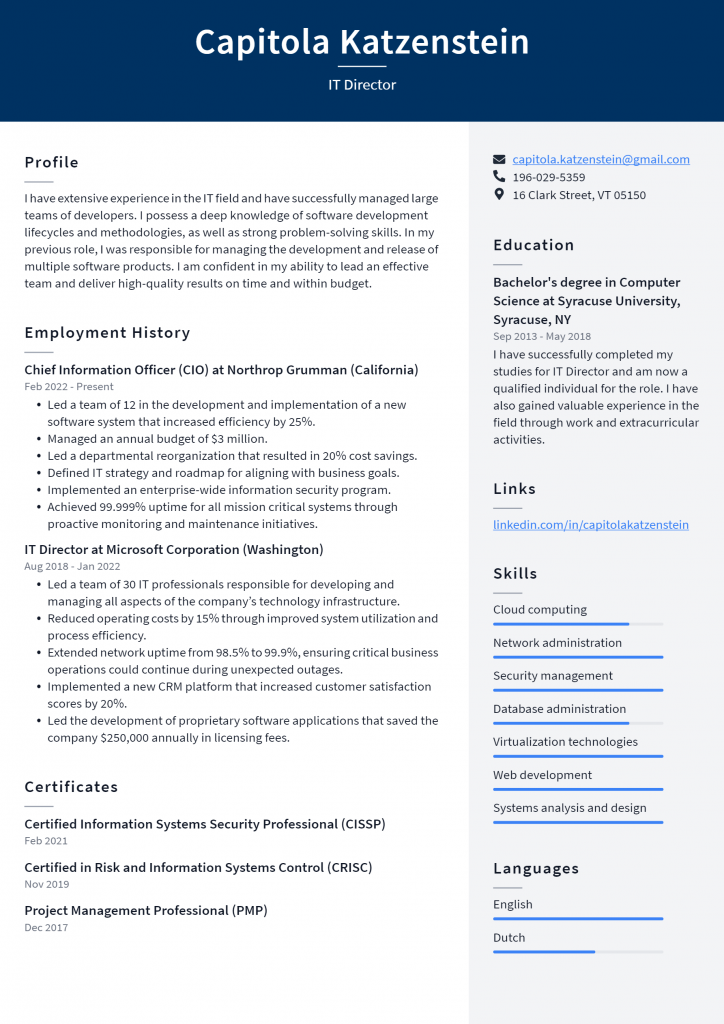Are you interested in working in information technology? Are you a master at fixing computers, smartphones, and other devices that can access the Internet? If so, an Information Technology (IT) Director resume could be the key to unlocking your dream job. An IT director is a high-level employee who leads and oversees other employees operating and maintaining computer systems within a company or organization. They also serve as a liaison between IT staff, upper management, and vendors contracted to provide IT services. An IT Director’s resume is designed to highlight your experience with computers and networking software and your leadership skills. When you’re ready to begin writing your resume, this guide will explain what should go into it, along with some examples to get you started.
IT Director Resume Example

Download This IT Director Resume as PDF
Chief Technology Officer (CTO) Resume Example
-resume-example-9Uaxb-724w.png)
Download This Chief Technology Officer (CTO) Resume as PDF
Vice President of Information Systems (VPIS) Resume Example
-resume-example-g2rMm-724w.png)
Download This Vice President of Information Systems (VPIS) Resume as PDF
Director of Information Systems (DIS) Resume Example
-resume-example-Jjmvv-724w.png)
Download This Director of Information Systems (DIS) Resume as PDF
Vice President of Information Technology (VPIT) Resume Example
-resume-example-zEFPU-724w.png)
Download This Vice President of Information Technology (VPIT) Resume as PDF
Chief Information Officer (CIO) Resume Example
-resume-example-MY4rg-724w.png)
Download This Chief Information Officer (CIO) Resume as PDF
Director of Information Technology (DIT) Resume Example
-resume-example-MwR5V-724w.png)
Download This Director of Information Technology (DIT) Resume as PDF
What Should Be Included in an IT Director Resume?
The first thing you should do when writing an IT Director resume is to list your qualifications and core skills. Here are some sample items you could include on your resume: If you have any certifications related to your profession, make sure to include those on your resume as well. Here’s a brief overview of the different sections you should include on your resume:
Summary of Qualifications
This is the first thing a potential employer sees when reviewing your resume, so you want it to be attention-grabbing and concise. In addition, you should include an overall summary of your qualifications, including any certifications, education, and experience in your field. This will allow your hiring manager to get a rapid idea of your background and whether you’re a good fit for the job.
Education
You should include the name of your degree and where you earned it, and the year you graduated. If you attended graduate school, you could also have the expected graduation year. You also want to include any relevant coursework or specializations you completed while studying. This section is critical if you’re applying for a job in academia.
Experience
This section should include the name of each company you’ve worked for, your job title and description, and the approximate dates you worked there. The experience section is where you’ll want to highlight any accomplishments you’re proud of and relevant skills you acquired while working in the field. You should also include any notable projects you were involved with and the outcome of each project.
Skills
It’s important to highlight your skills section on your IT Director resume because it shows hiring managers how you can benefit the company. You can include technical and non-technical skills, but make sure to back up any claims about your abilities. You should also include any languages you speak and relevant computer software you know how to use. Another essential section of your computer proficiency has your ability to operate multiple software programs and work with various computer systems, including mobile devices.
Other Important Content
Now that you have a general idea of what should go into your resume, there are a few other essential things to consider. The first is your overall resume format. While there are many formats to choose from, some more traditional than others, a functional resume is the most common format for an IT Director’s resume. Functional resumes focus on your skills and experiences rather than your work history. This type of resume benefits people who are changing careers or want to highlight skills they’ve gained outside their regular job duties. It would help if you proofread your resume, looking for any errors or typos.
Conclusion
Now that you know what should go into an IT Director resume, you can start to write your own. Make sure to include all the most critical information, such as your skills, qualifications, and experience. You should also make sure to choose a format that best highlights your skills and experience, whether that’s a chronological or functional resume. Then, if you’re ready to begin applying for IT Director jobs, this guide will help you create an effective resume.